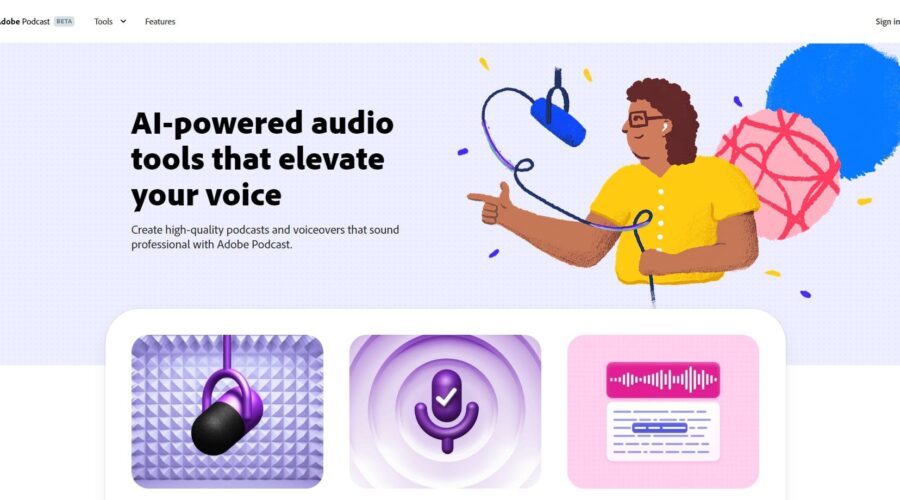Adobe, the world-renowned leader in creative software, has recently entered the field of AI-powered audio editing with the launch of Adobe Podcast AI. This innovative new platform can help podcasters of all levels create high-quality, professional-sounding podcasts.
In this post, we’ll take a comprehensive look at Adobe Podcast, including its features, benefits, practical applications, and safety concerns. We will also compare it to other AI-powered audio editing technologies to help you decide if it is the right fit for your podcast.
What is Adobe Podcast AI?
Adobe Podcast AI is an innovative cloud-based service that uses artificial intelligence (AI) to enhance podcasting with voiceovers and other audio editing tools. Like other top AI audio tools, this platform utilizes AI algorithms to analyze podcast audio content and generate transcripts, captions, keywords, and summaries. It can also help with noise reduction, echo reduction, vocal enhancement, automated editing, and more. It is available as a web application and an integral part of the Adobe Creative Cloud subscription.
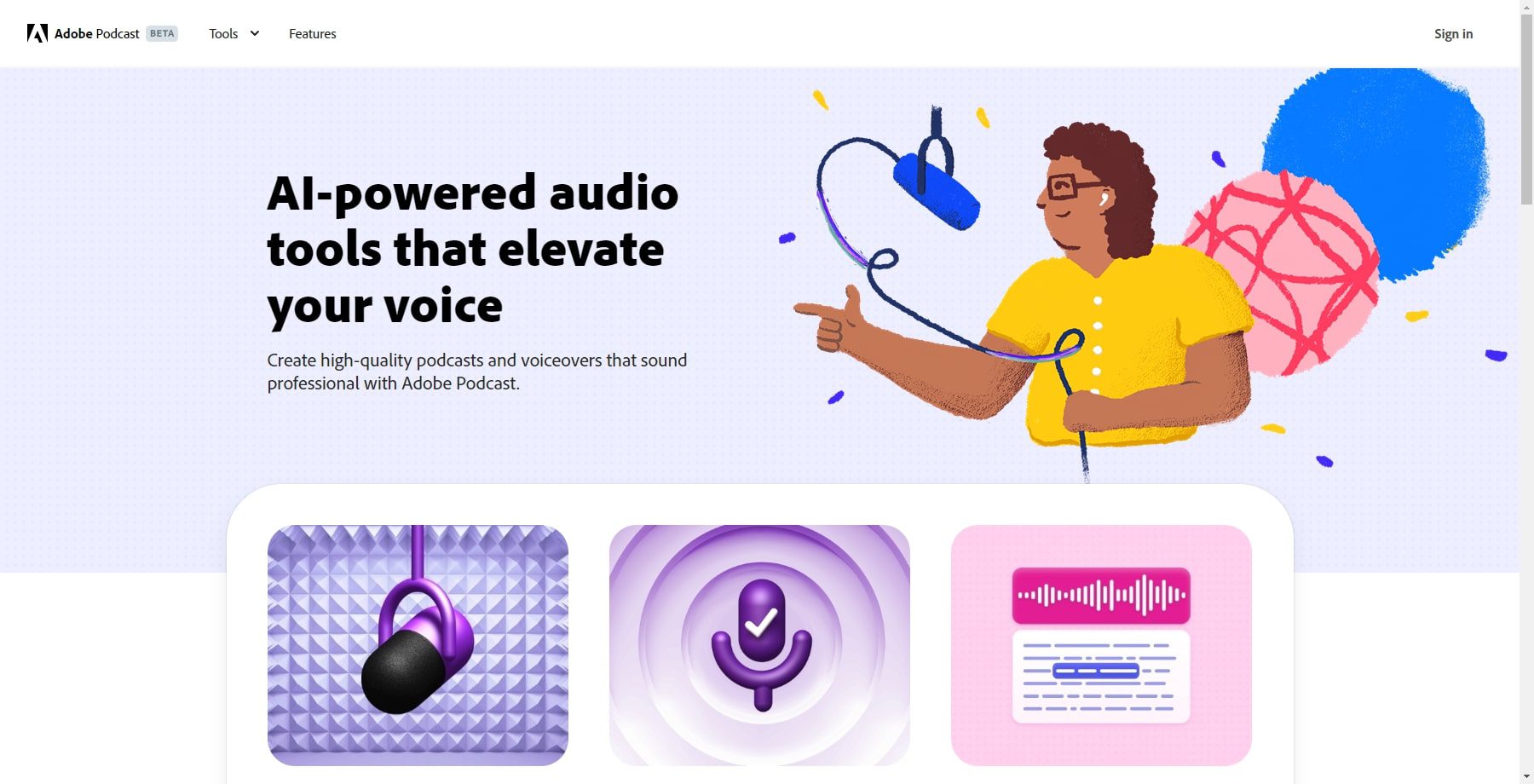
Adobe Podcast AI is built on the same cutting-edge AI technology that powers other Adobe products, such as Adobe Audition, Photoshop, Premiere Pro, and After Effects. This means podcasters can benefit from the same powerful AI capabilities that have revolutionized photography, video editing, and motion graphics.
Adobe Podcast AI vs Adobe Audition
Although Adobe Podcast AI offers an innovative, easy-to-use platform catered to podcasters, it is currently still in beta at the time of writing this post. So, it may not have the same audio editing capabilities as Adobe Audition.
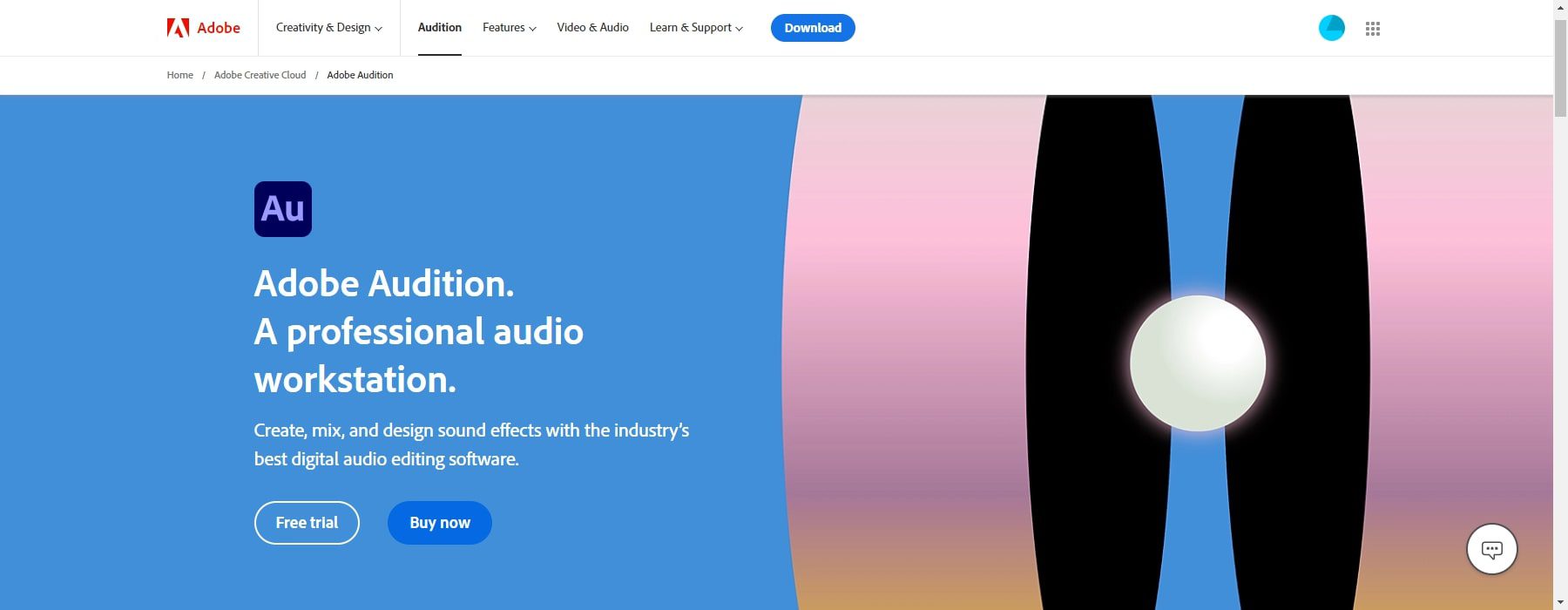
Adobe Audition is a digital audio workstation (DAW) that caters to a diverse range of professional audio creators, including musicians, producers, sound designers, and podcasters. Unlike the simplified cloud-based approach of Adobe Podcast AI, Adobe Audition offers a comprehensive suite of audio editing, recording, and mixing tools that have been honed over the years.
While Adobe Podcast AI is tailored to be user-friendly, Adobe Audition is a more sophisticated software solution, which may require a deeper understanding and familiarity with audio editing techniques. Additionally, it’s important to note that Adobe Podcast AI offers a free version, while Adobe Audition requires a subscription to access its extensive capabilities. These two Adobe products cater to distinct audiences and provide varying levels of functionality to meet their unique audio editing needs.
Adobe Podcast AI Features
Adobe Podcast AI includes powerful features that can help podcasters create high-quality podcasts, even if they don’t have professional equipment or expertise. Here, we will overview all those features and their influence.
1. Enhance Speech: Noise and Echo Removal
This AI-powered platform’s “Enhance Speech” feature is a game-changer for podcasters and content creators. It leverages advanced AI algorithms to improve the quality of audio recordings by tackling two primary challenges: background noise and echo. The feature transforms ordinary recordings into professional-sounding audio content by meticulously removing these disturbances.
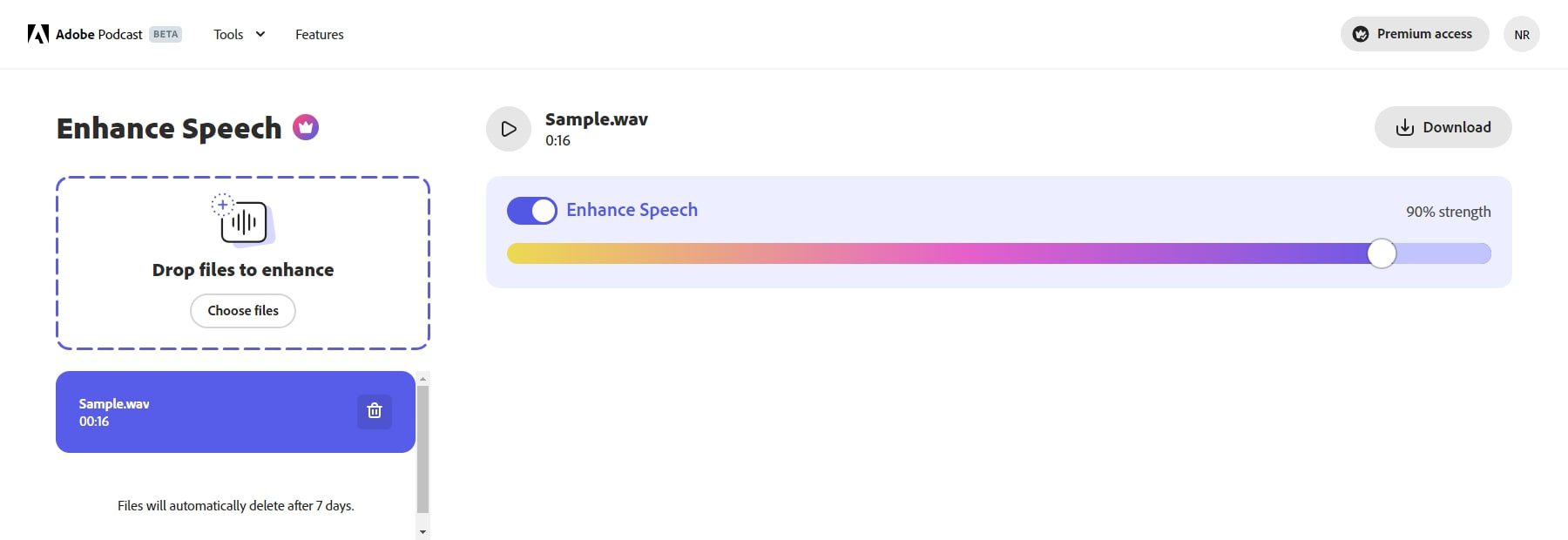
Users can upload audio files with a few specifications to maximize this feature. The supported file type is audio, and the duration should not exceed 1 hour, ensuring that longer recordings can also benefit from this enhancement. The file size should be 500MB or less, accommodating a wide range of audio files. Additionally, a daily limit of 3 hours ensures fair service usage. Users can preview the enhanced audio quality before downloading the final result to their local computer.
2. Mic Check: Microphone Issues Detection and Resolution
The “Mic Check” feature identifies and resolves microphone-related issues like low audio levels or distortion. Addressing these common problems, “Mic Check” ensures recordings maintain high clarity and intelligibility.
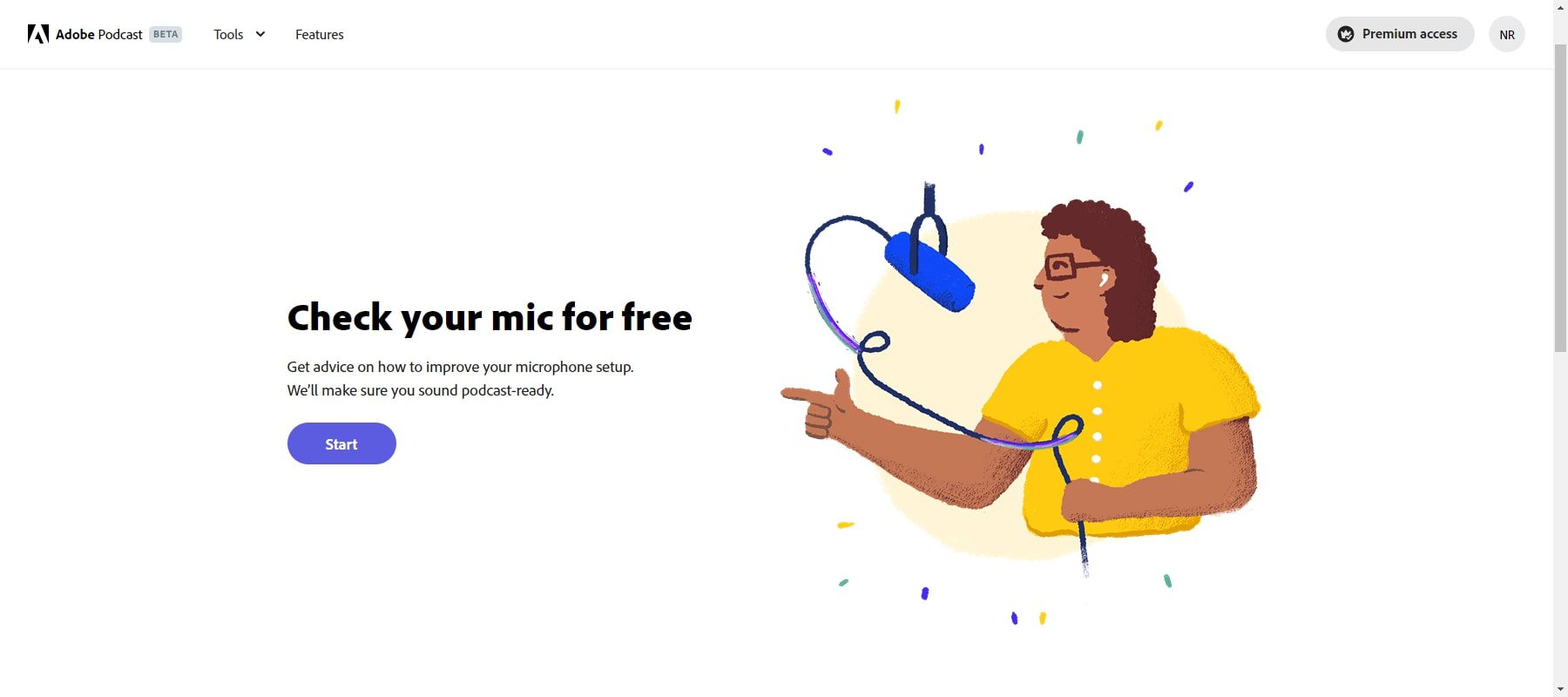
Using the Mic Check to test your mic is pretty straightforward. You’ll need to grant microphone permission while using this tool, allowing it to provide accurate guidance and maximize the quality of audio recordings. After you give access, click the “Test mic” button and say, “How is my microphone setup and placement?”. After that, it will provide an overview of microphone-related issues similar to my results in the screenshot below.

The microphone-related overview is based on the following four factors:
- Distance to the microphone: The high distance in the results suggests that I am too far away from the microphone.
- Gain: The high gain in the results suggests that my voice is distorted.
- Background noise: There is no background voice in the tested audio, which shows the listeners can easily hear my voice.
- Echo: The feature measured less echo in my environment. Echo can occur when the user’s voice is reflected back to them from a hard surface, such as a wall.
After underlining all the issues, I did a mic test again. This time, I was successful in clearing all of their tests. The “Mic Check” feature also allows listening to my voice.
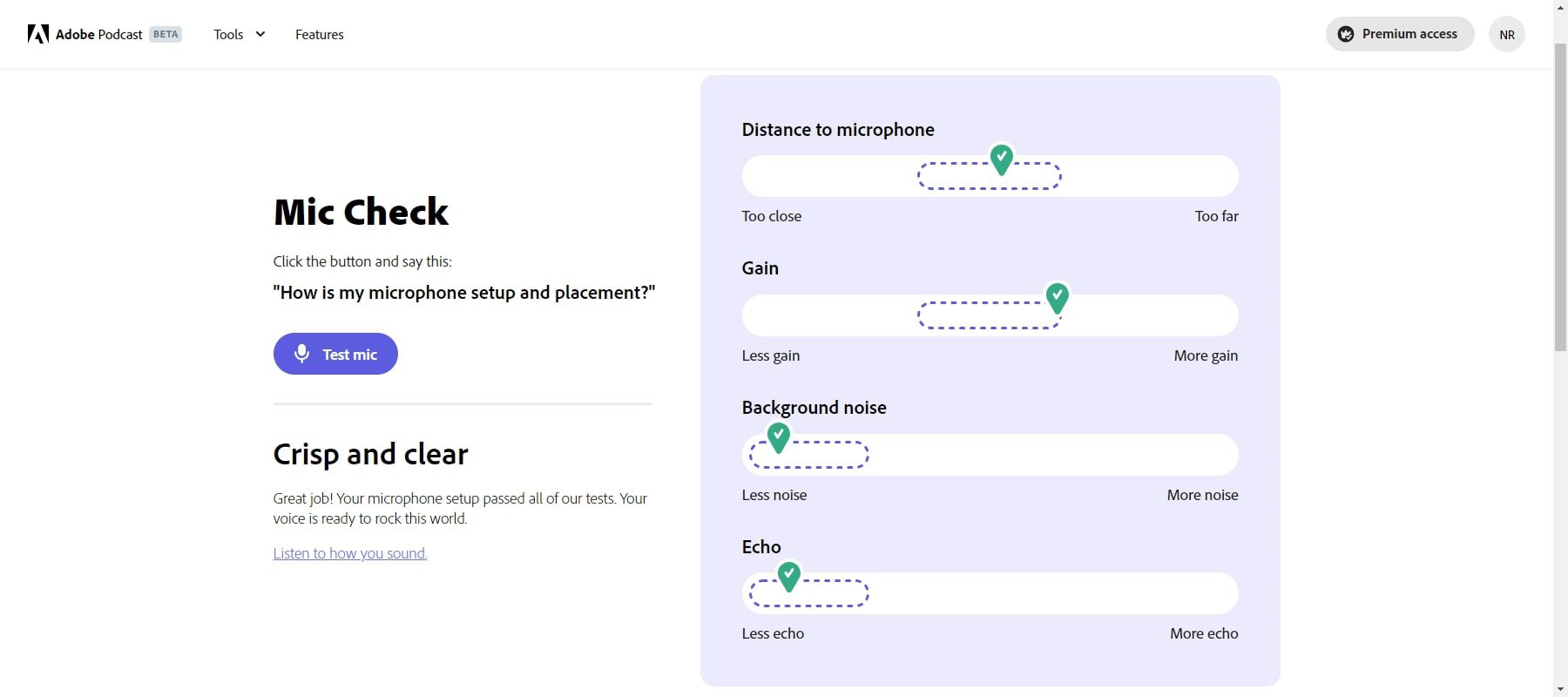
3. Studio: In-Browser Recording, Editing, and Enhancing
The “Studio” feature of Adobe Podcast AI is a versatile and accessible web-based application tailored to podcasters’ needs. With “Studio,” podcasters can record their audio and engage in sophisticated editing tasks, including working with multiple tracks, incorporating music and sound effects, and fine-tuning audio levels to perfection. Like the “Mic Check” feature, Adobe Podcast AI asks for your permission before creating a new project.
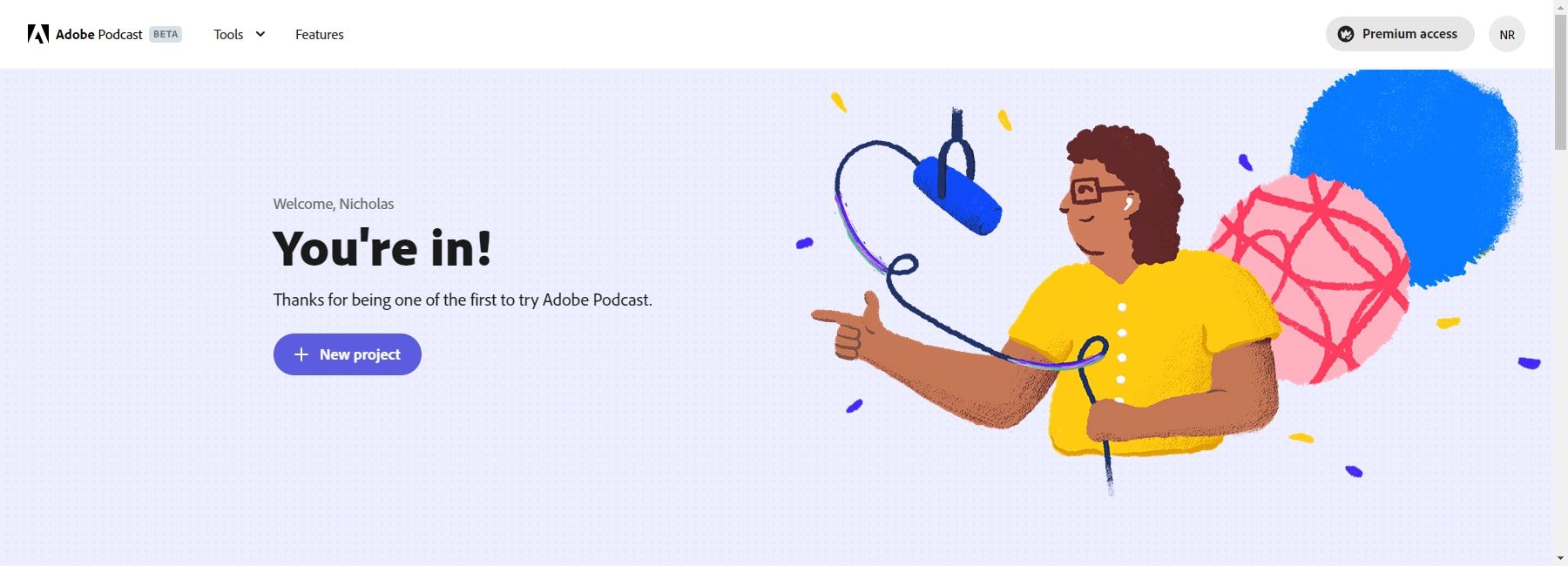
Once you enter the “Studio,” you can start recording or involve other participants in your podcast. Moreover, you will be provided with the following four options.
- Upload: You can upload your music and recordings directly on the Studio.
- Music: You can select music from the customized collection or upload your music.
- Placeholder: Mark where a particular piece of content will be added later.
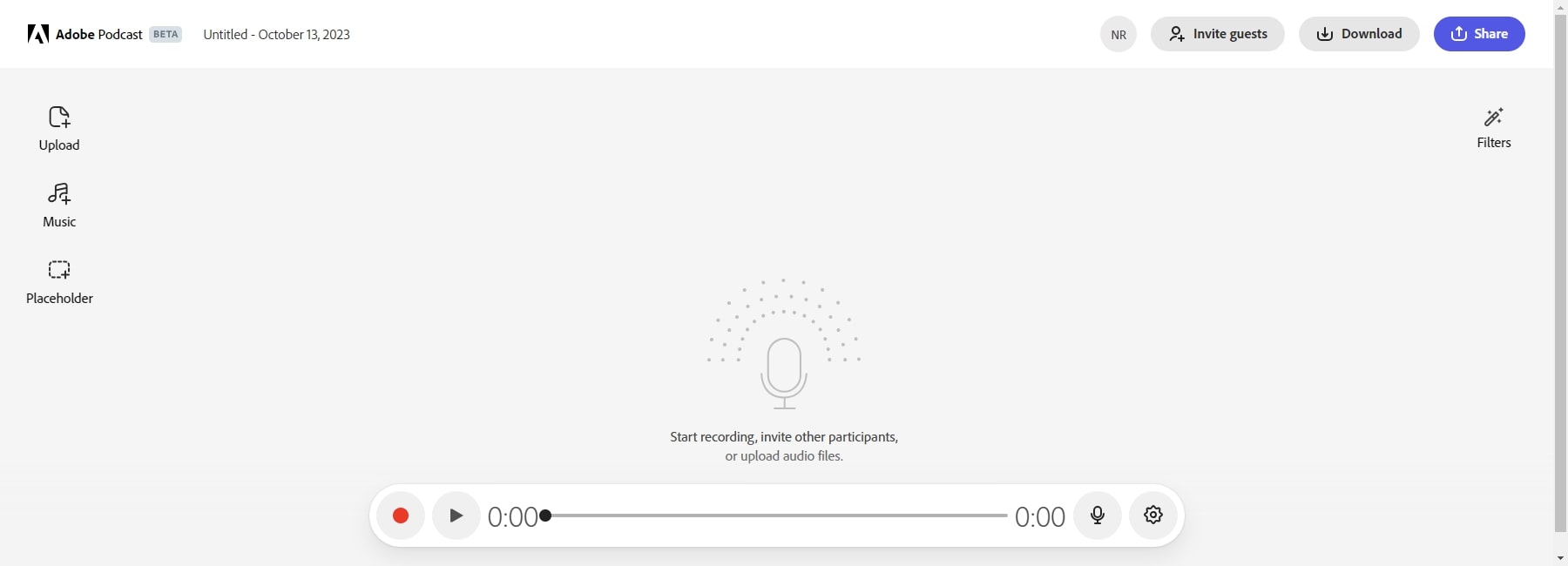
- Filters: Activate the “Enhance Speech” feature for your recorded audio.
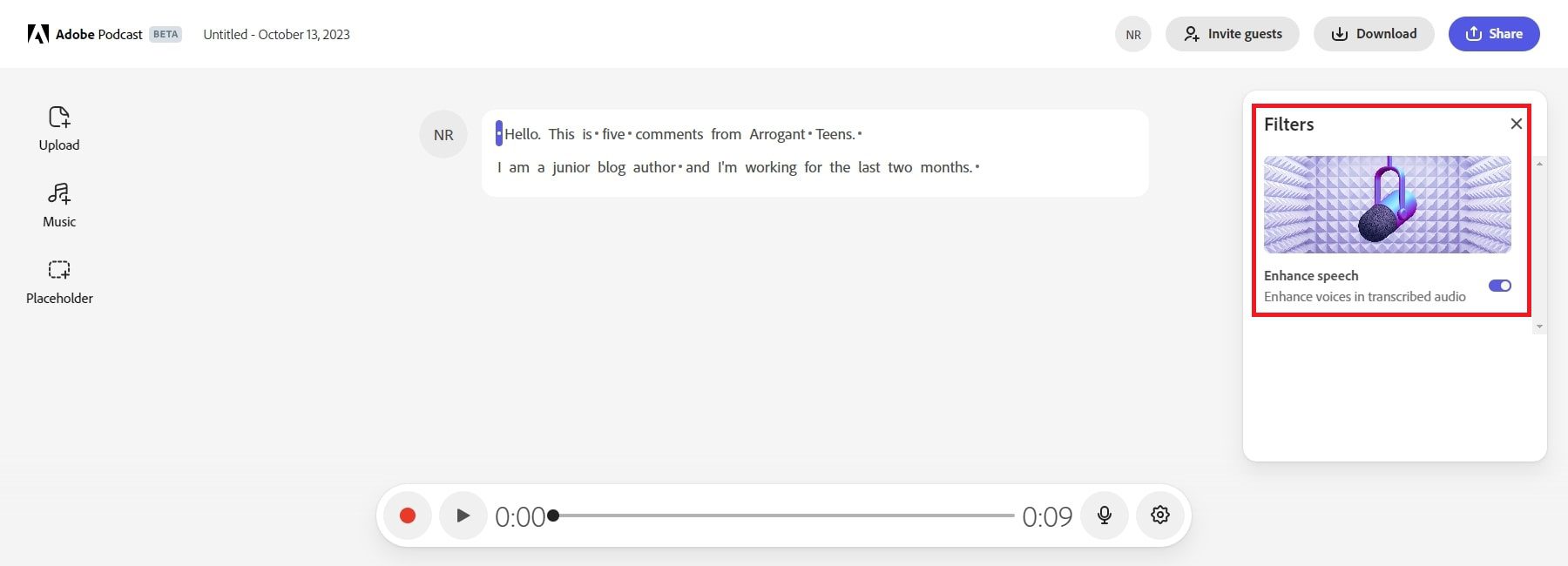
4. AI-Powered Transcription and Editing
The AI-powered transcription and Editing feature within Adobe Podcast Studio offers automatic transcription of audio recordings. It simplifies the process of editing and searching through audio files. This feature is an invaluable time-saver for podcasters, particularly when creating comprehensive episode notes or transcripts. With the ability to seamlessly cut, copy, and paste audio just like a text document, audio editing has never been more efficient.
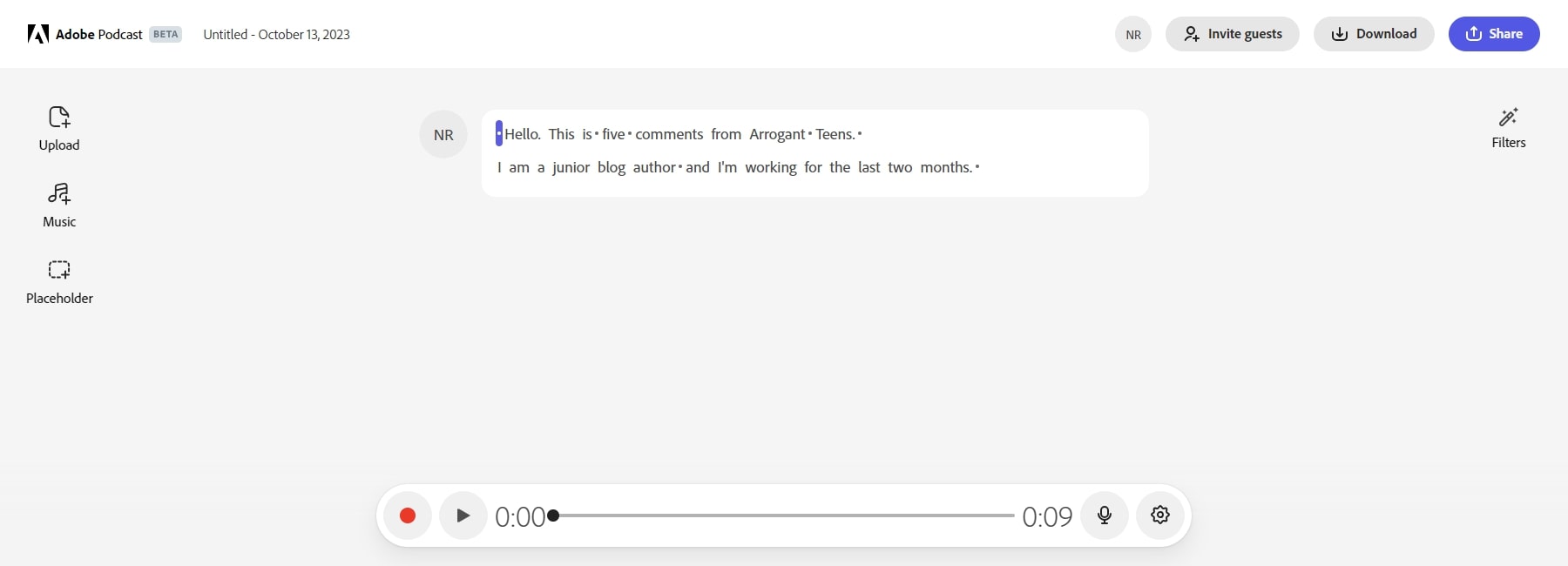
In my case, I recorded an audio of nine seconds, in which I assumed to be giving an introduction. In that audio, there were a few words that were wrongly transcribed. For example, it transcribed “Elegant Themes” as “Arrogant Teens.” You can edit it by clicking on the wrong word and clicking on “Correct Transcript.”
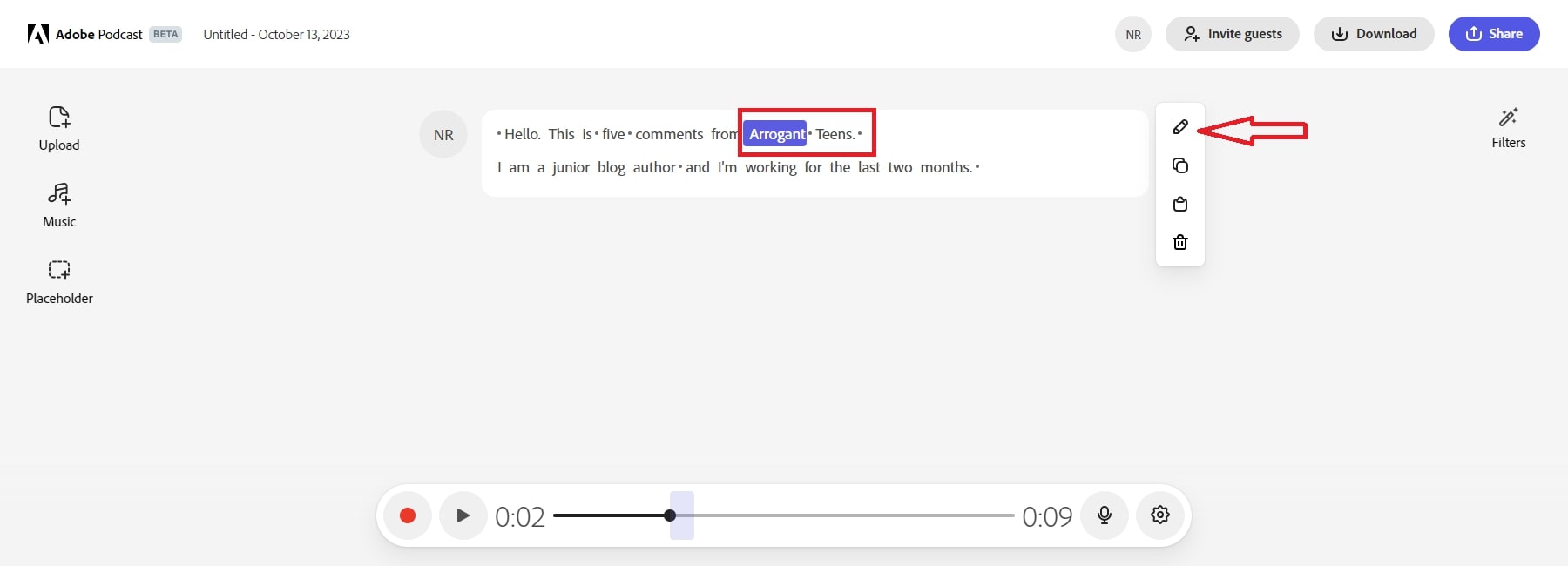
We made corrections to all the transcribed audio. For example, there was another name in which the name “Fahad Hamid” was wrongly transcribed as “Five Comments.” The final transcribed audio looked like the following.
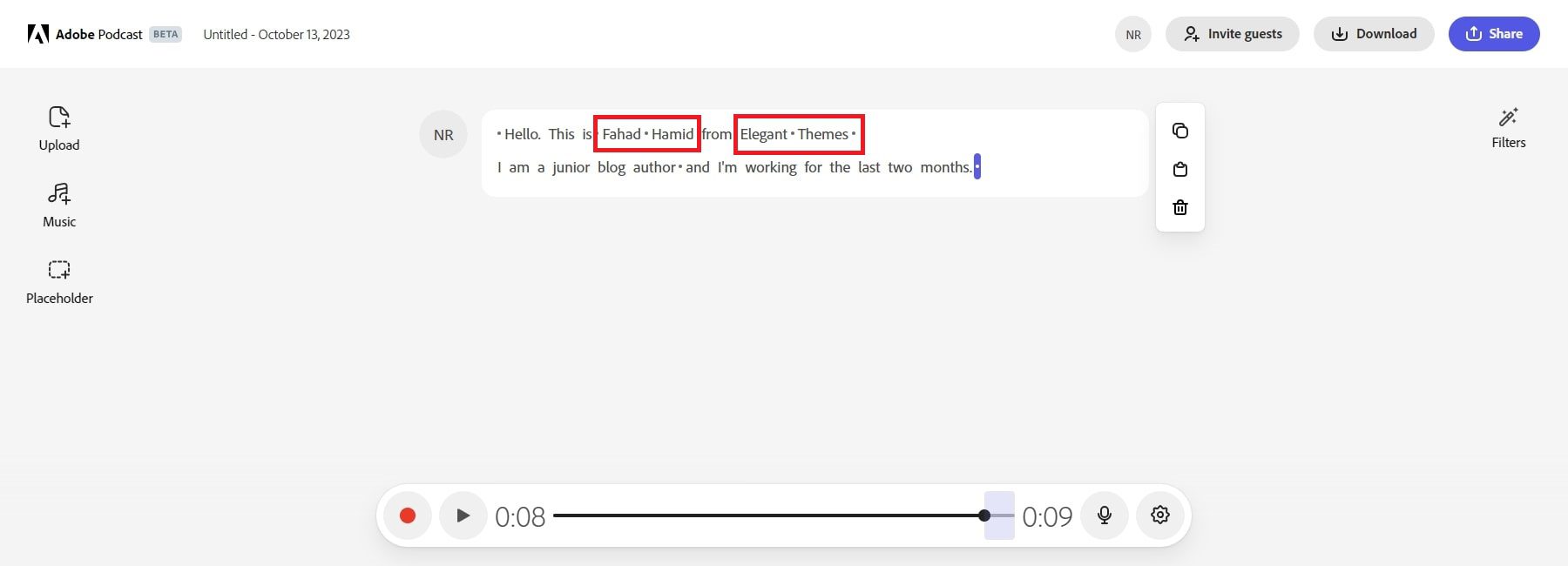
5. Professional-Grade Recording with Remote Guests
The “Professional-Grade Recording with Remote Guests” feature grants the ability to record podcast episodes with remote guests, even when they face challenges with their internet connections. It achieves this by capturing each participant’s audio as individual tracks in 16-bit 48k WAV format, ensuring professional-grade audio consistency.
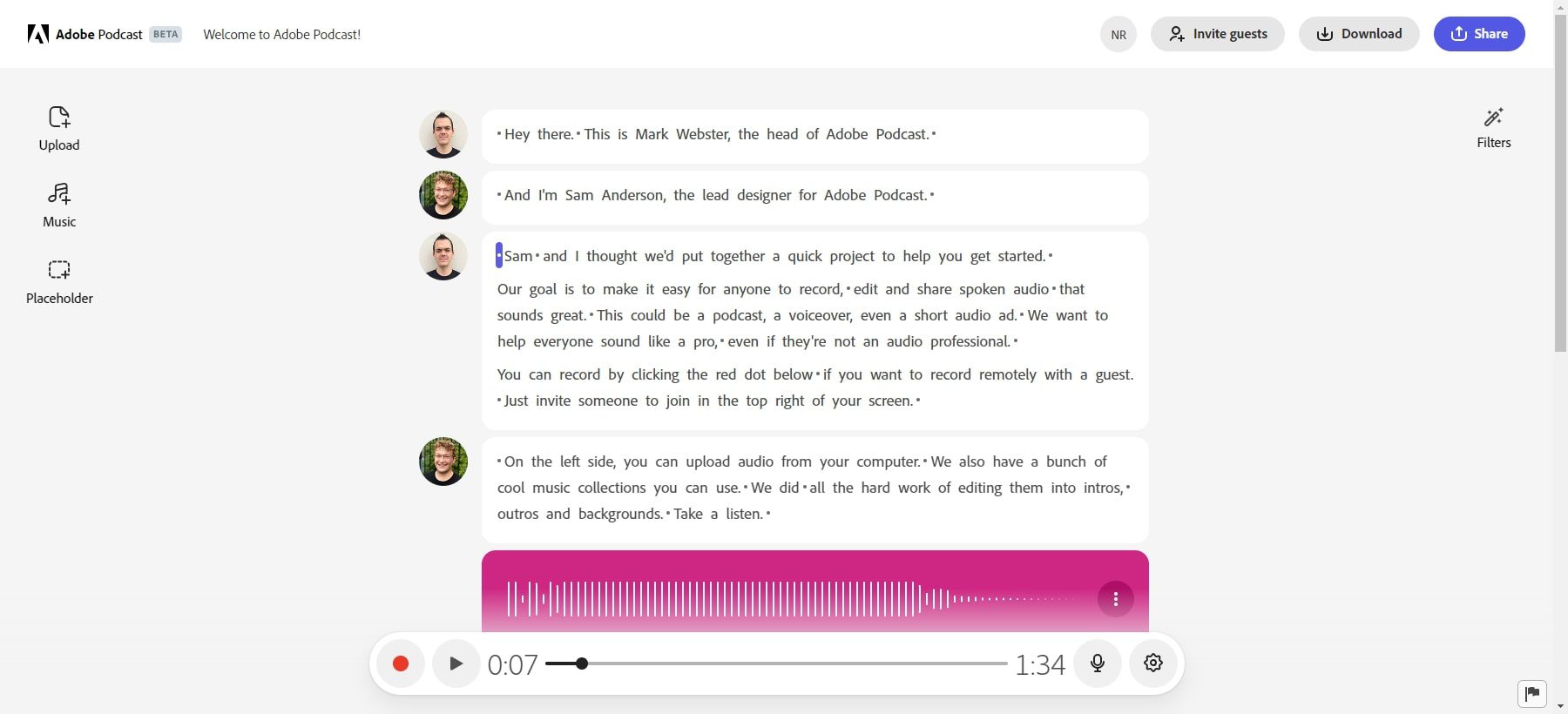
In the example above, you can see a recorded audio in which the representatives of Adobe Podcast give an overview of getting started with this tool. The images of both users can also be seen beside their recorded messages. This is great for collaboration and managing snippets during the editing process.
6. Pre-Edited Royalty-Free Music
Adobe Podcast Al’s Pre-Edited Royalty-Free Music feature offers a treasure trove of podcast-ready musical elements, encompassing intros, outros, transition sounds, and background music. This comprehensive library of pre-edited, royalty-free music presents a significant boon to podcasters.
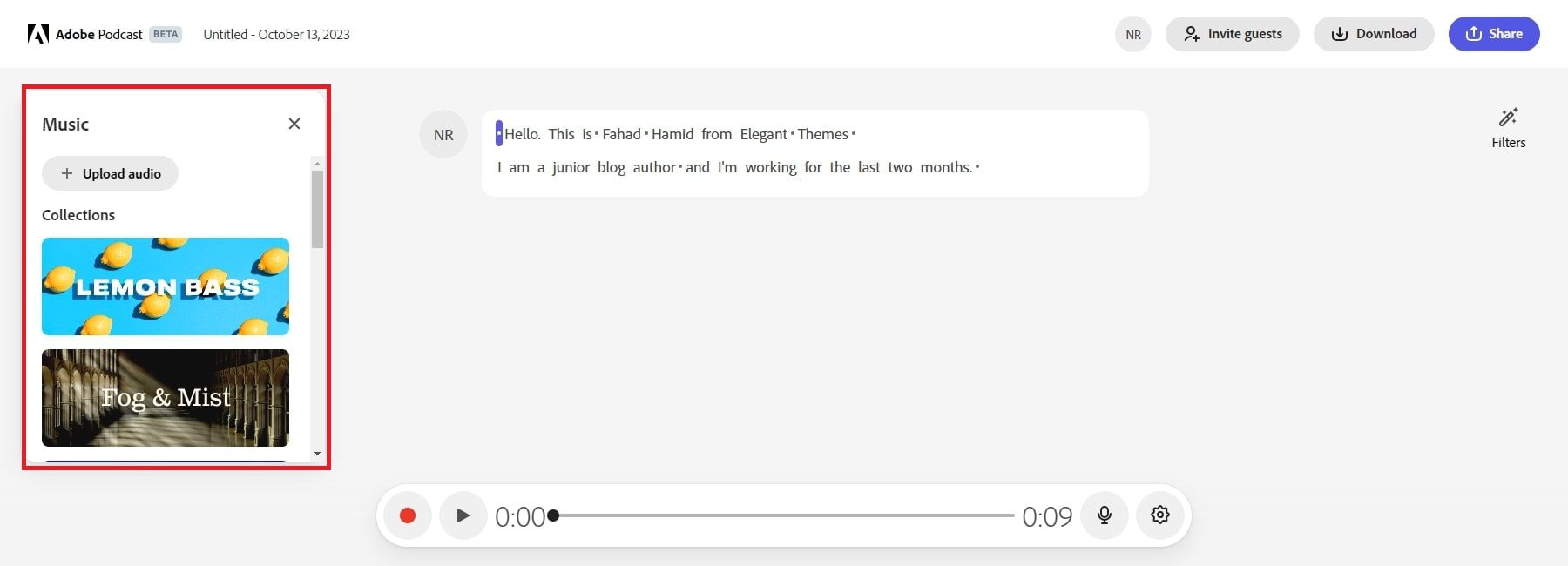
Podcasters no longer need to invest time and resources in creating music compositions or navigating the complexities of licensing music from external sources.
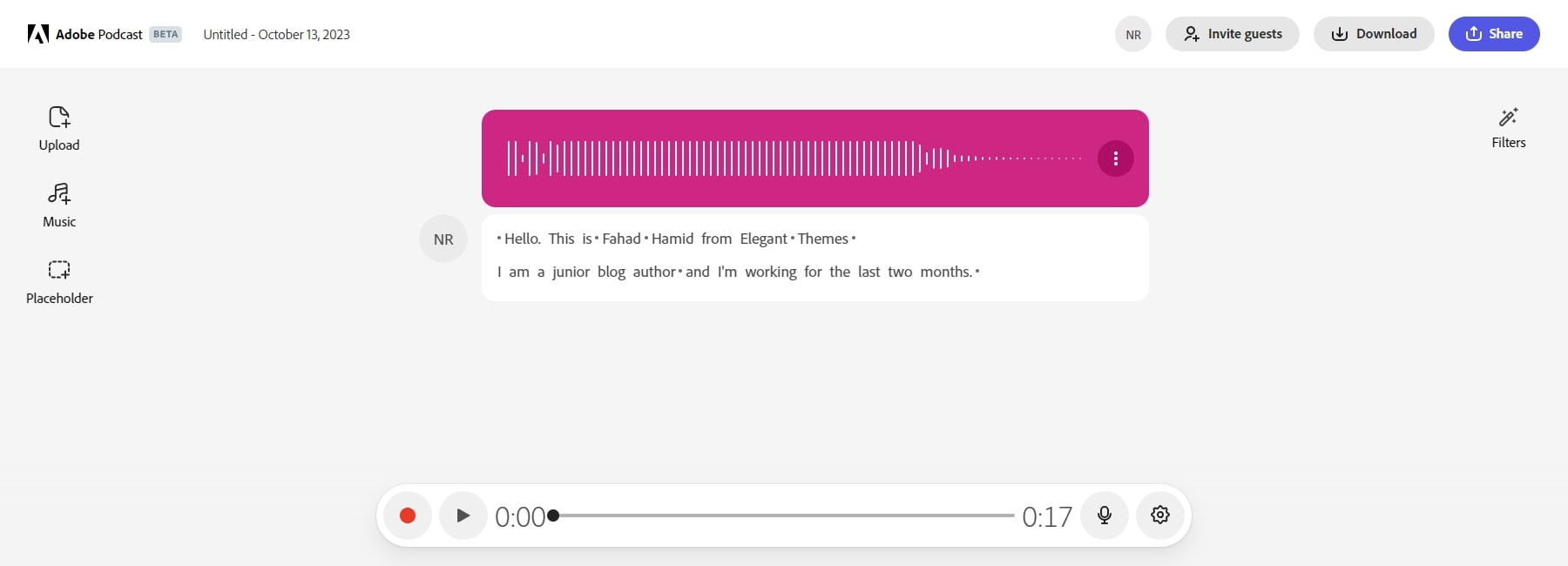
Although the recorded messages are the bread and butter of every conversation, adding intro music can help set the mood. Music is available from the provided library. We can choose to modify the music overlay by clicking on the following options:
- Fade in
- Fade out
- Set as background
- Transcribe (given the fact that the music contains lyrics)
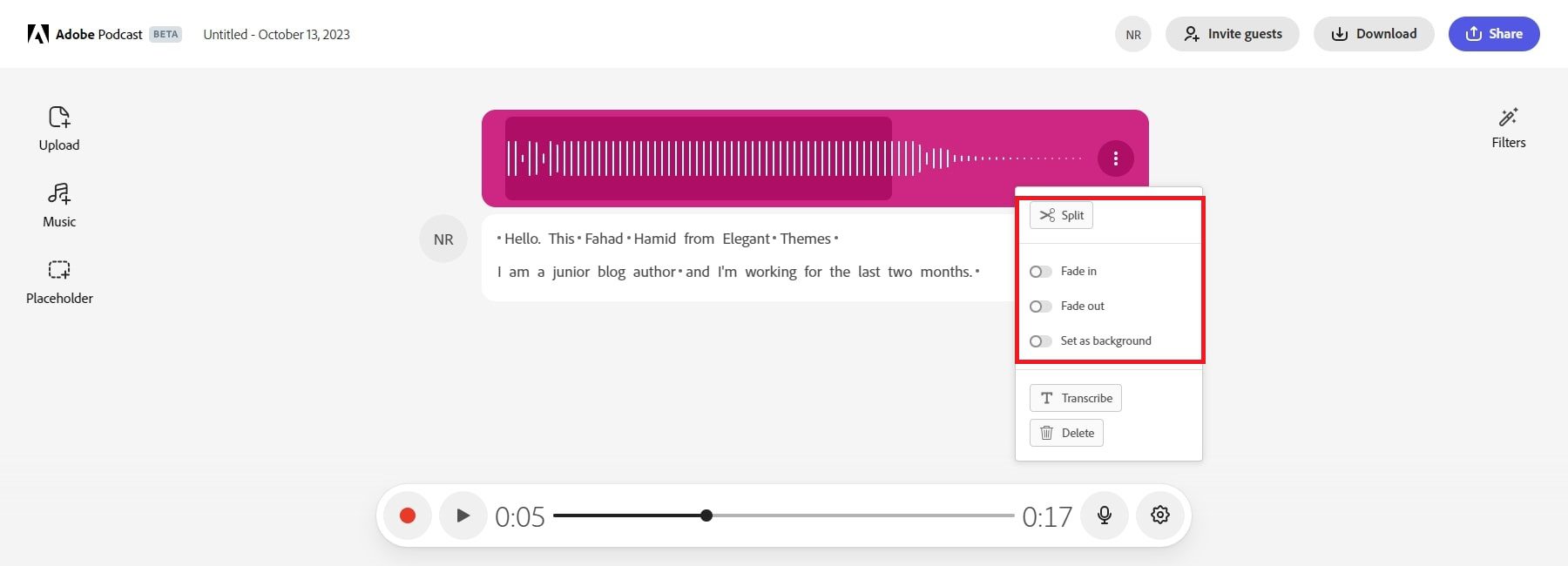
Podcasters who don’t need all the bells and whistles of other robust platforms will appreciate this simplified audio editing process.
Practical Applications and Benefits
Adobe Podcast AI offers a transformative solution for content creators, marketers, and various audiences. Here are a few ways you can use it to your benefit:
- High-Quality Audio Recording and Enhancement – Adobe Podcast AI allows for high-quality podcast recording, no matter the equipment. It enhances the sound by removing background noise, reducing echo, and sharpening vocal clarity, providing a polished auditory experience for your listeners.
- Simplified Editing Tasks – The platform streamlines tedious editing tasks like trimming clips, integrating music and sound effects, and adjusting audio levels. This simplification is especially helpful for those new to the podcasting world.
- Automatic Transcription – An automatic transcription feature in Adobe Podcast AI makes the creation of episode notes or transcripts a breeze, adding another layer of accessibility and SEO value to your podcast.
- Custom Music Generation for Podcasts – Adobe Podcast AI goes beyond typical features by generating custom intro and outro music. This adds a unique sonic identity to each podcast, allowing you to stand out from the crowd.
- Multi-Application Versatility – Not just for podcasts, Adobe Podcast AI can do voiceovers for videos or animations, and it can enhance the audio quality of interviews or conversations. This makes it a versatile tool for both personal and business applications.
From Adobe subscribers to stock contributors, everyone stands to gain from the suite of top-notch tools Adobe Podcast AI offers, making podcasting more efficient and creative.
How It Stacks Up
Adobe Podcast AI faces competition from other AI-powered podcasting platforms, such as Descript and Podcastle. Therefore, it is helpful to discuss some of the advantages and disadvantages Adobe Podcast may have in light of other platforms.
Advantages
Adobe Podcast AI does some things very well and has stand-out features worth mentioning. For example, the Enhance Speech tool significantly reduces background noise and enhances the clarity of the speaker’s voice.
Moreover, the “Mic Check” tool ensures pristine audio quality by allowing users to assess microphone and audio settings before recording.
Transcribing audio content is a breeze with Adobe Podcast AI, and this is a must-have feature for those looking to refine and publish their podcasts.
Multitrack recording is another standout feature, empowering users to capture multiple audio tracks simultaneously. It is perfect for hosting discussions with multiple participants or seamlessly incorporating sound effects and music.
This powerful tool has a user-friendly interface, enabling seamless audio recording, trimming, cutting, and pasting. You can effortlessly add music, sound effects, and smooth podcast transitions within one convenient platform.
Adobe Podcast AI integrates with other Adobe software, including Adobe Audition, Premiere Pro, and more, to maximize your audio and video editing capabilities for your podcasts.
Disadvantages
Despite its advantages, Adobe Podcast AI has several areas where it could improve to compete with platforms like Descript and Podcastle.
It is worth noting that Adobe Podcast is still in beta, so we can expect some flaws and limitations that would exist in any new product. For example, when reducing background noise, sometimes the audio voices sound flat and less natural. And sometimes you may notice some weird distortion added to the audio that wasn’t there before. It isn’t well suited for producing high-quality music recordings, so don’t expect too much from the pre-recorded background music or the editing process.
The premium version is more costly than its competitors, and it has limited features in the free version. You can unlock a few more features for Adobe Podcast by purchasing Adobe Express Premium, which is almost double the price of Descript and Podcastle. Although this gives you additional access to the design features of Adobe Express, it doesn’t deliver the same amount of audio editing features (or video features) as other competitors, at least not yet.
Although it has much to improve in its beta stage of development, Adobe Podcast seems to have a solid foundation of AI features that podcasters can use to streamline their workflow.
Wrapping Up
Adobe Podcast AI is an innovative platform with high-quality audio editing, AI-powered transcription, and professional-grade remote recording capabilities. It simplifies podcast production by offering pre-edited, royalty-free music, saving time and money for creators.
While it marks a significant step forward, serious podcasters may find it lacks the robust audio editing features of Adobe Audition and other competitors. Plus, its lack of video editing leaves it lacking that all-in-one solution some may find in AI video generation platforms like Descript. However, as generative AI advances, we can expect Adobe to continue to improve this platform.
Are you looking for more tools? Check out our breakdown of the best AI audio software and video editors for podcasters. And if you are looking for somewhere to host your podcast, here are some of the best Podcast hosting platforms.
Also, don’t miss our ultimate list of the best AI tools to boost productivity.
The post Adobe Podcast AI: Honest Review & Beginner’s Guide (2023) appeared first on Elegant Themes Blog.
